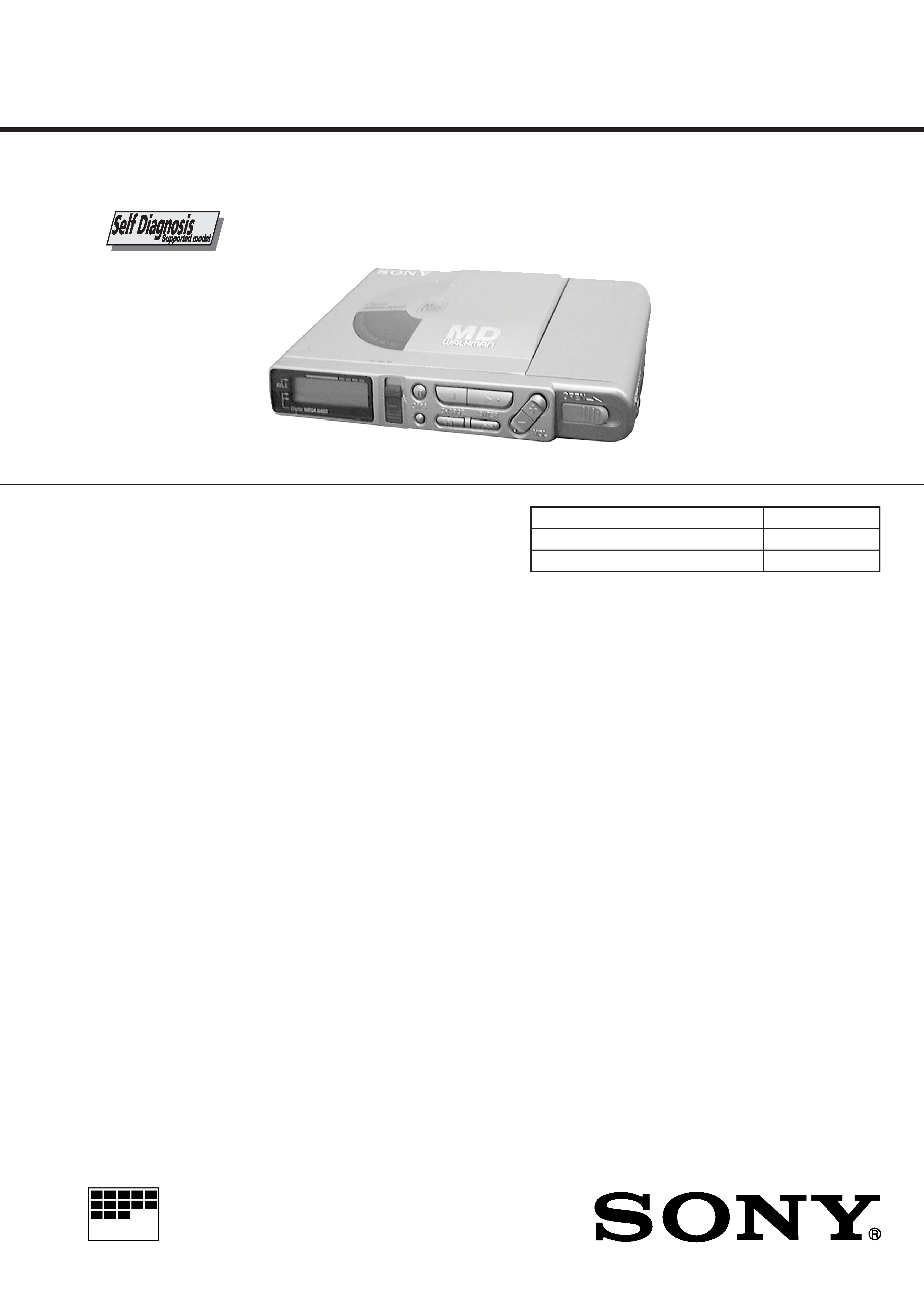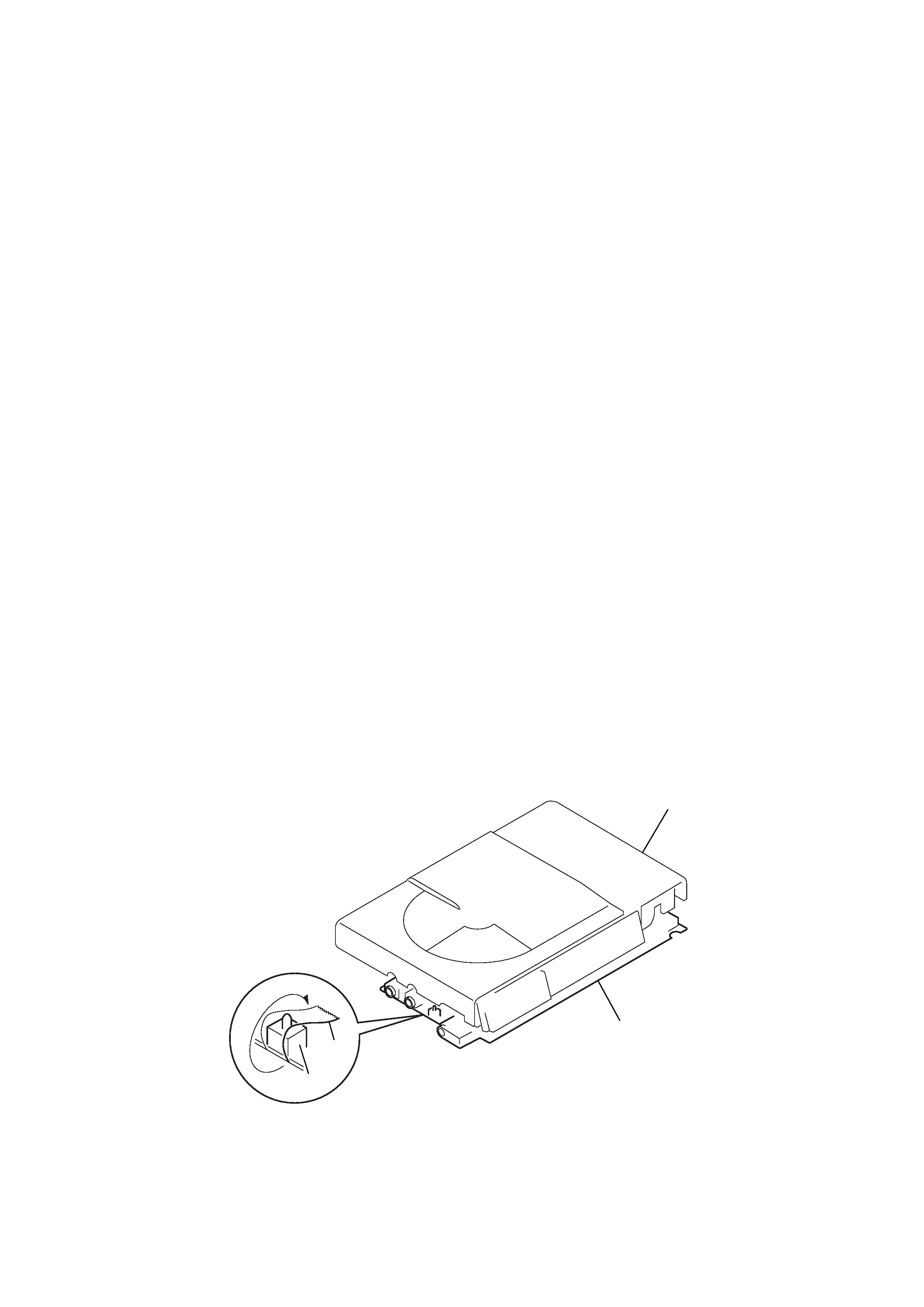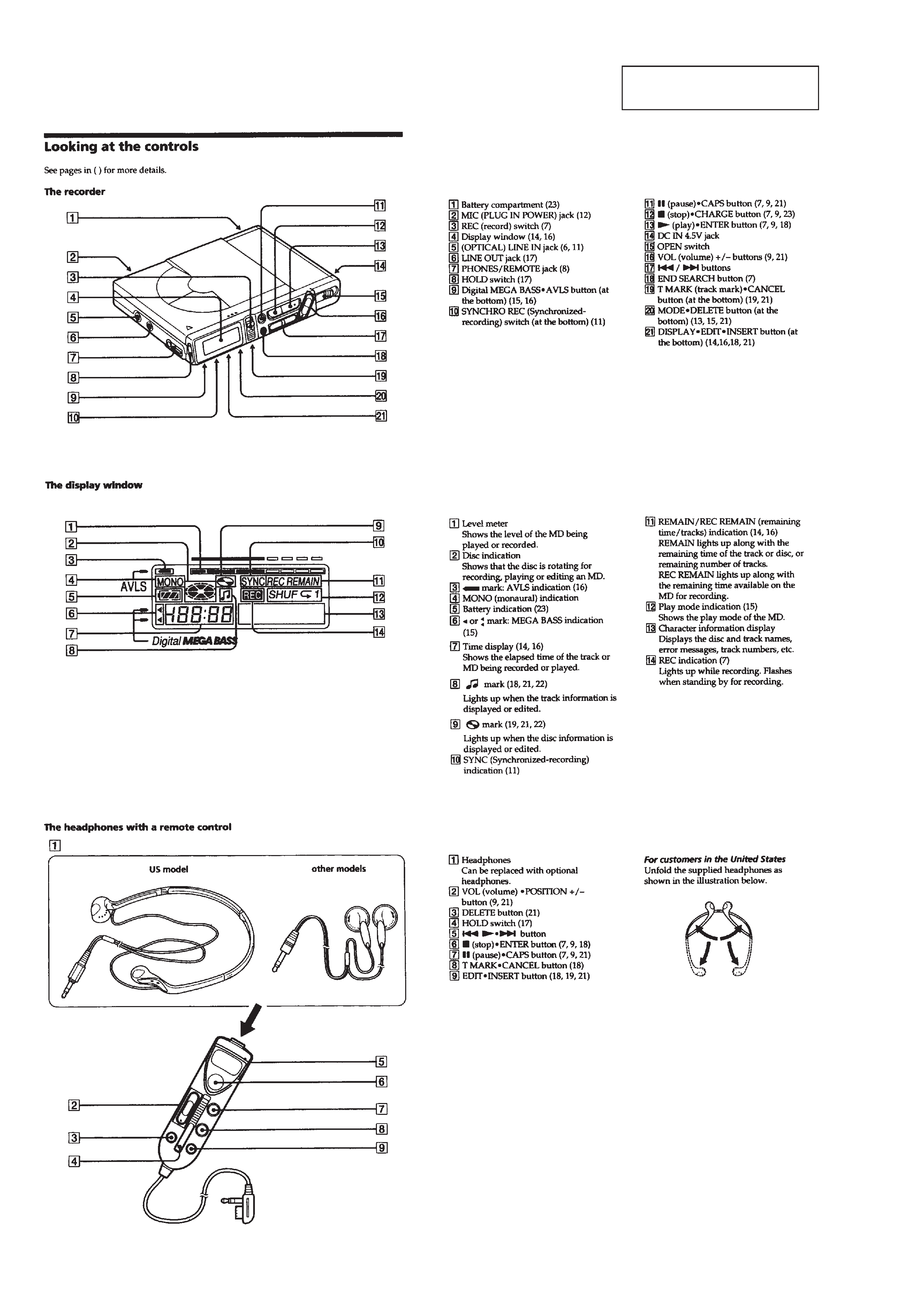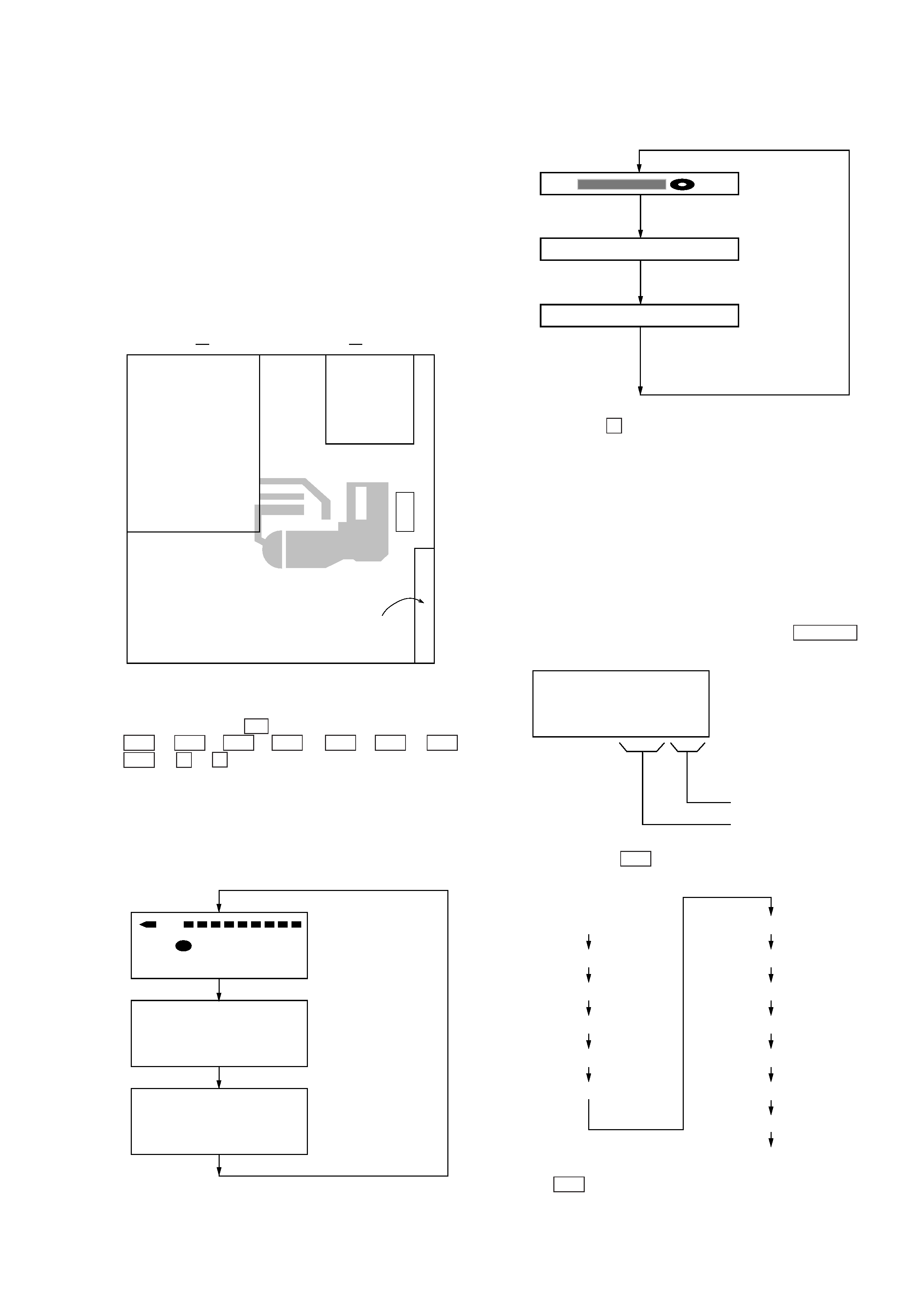
1
MICROFILM
MZ-R37
SERVICE MANUAL
PORTABLE MINIDISC RECORDER
SPECIFICATIONS
US Model
Canadian Model
AEP Model
UK Model
E Model
Australian Model
Tourist Model
Model Name Using Similar Mechanism
MZ-R55
MiniDisc Mechanism Type
MT-MZR37-161
Optical Pick-up Type
KMS-280A
US and foreign patents licensed from Dolby Laboratories
Licensing Corporation.
System
Audio playing system
MiniDisc digital audio system
Laser diode properties
Material: GaAlAs
Wavelength:
= 780 nm
Emission duration: continuous
Laser output: less than 44.6
µW
(This output is the value measured at a
distance of 200 mm from the lens surface on
the optical pick-up block with 7 mm
aperture.)
Recording and playback time
Maximum 74 minutes (MDW-74, stereo
recording)
Maximum 148 minutes (MDW-74, monaural
recording)
Revolutions
400 rpm to 900 rpm (CLV)
Error correction
Advanced Cross Interleave Reed Solomon
Code (ACIRC)
Sampling frequency
44.1 kHz
Sampling rate converter
Input: 32 kHz / 44.1 kHz / 48 kHz
Coding
Adaptive TRansform Acoustic Coding (ATRAC)
Modulation system
EFM (Eight to Fourteen Modulation)
Number of channels
2 stereo channels
1 monaural channel
Frequency response
20 to 20,000 Hz ± 3 dB
Wow and Flutter
Below measurable limit
Inputs
MIC (PLUG IN POWER): stereo mini-jack,
0.351.38 mV
(OPTICAL) LINE IN: stereo mini-jack with
optical (digital) in
· Line in: 69194 mV
· Optical (digital) in: wave length 660 nm
Outputs
PHONES/REMOTE: stereo mini-jack,
maximum output level 5 mW + 5 mW, load
impedance 16 ohm
LINE OUT: stereo mini-jack, 194 mV, load
impedance 10 kilohm or greater
General
Power requirements
Sony AC Power Adaptor (supplied)
connected at the DC IN 4.5 V jack:
120 V AC, 60 Hz (US, Canadian model)
220230 V AC, 50/60 Hz (AEP model)
230240 V AC, 50 Hz (UK model)
240 V AC, 50 Hz (Australian and New Zealand model)
Two nickel-cadmium rechargeable batteries
NC-AA (supplied)
Two LR6 (size AA) alkaline batteries (not supplied)
Continued on next page
Ver 1.1 1999. 04

2
Battery operation time1)
Batteries
Recording2)
Playback
Two NC-AA
Approx.
Approx.
nickel-cadmium
3 hours
5 hours
rechargeable batteries
Two LR6 (size AA)
3)
Approx.
Sony alkaline dry batteries
13 hours
1)The battery life may be shorter due to
operating conditions and the temperature
of the location.
2) When you record, use fully charged
rechargeable batteries.
3) Recording time may differ according to the
alkaline batteries.
Dimensions
Approx. 116.8
× 18.5 × 86.1 mm (w/h/d)
(4 5/8
× 3/4 × 3 1/2 in.)
Mass
Approx. 160 g (5.6 oz) the recorder only
Approx. 220 g (7.8 oz) incl. a recordable MD,
and two NC-AA nickel-cadmium
rechargeable batteries
Supplied accessories
Optical cable (1) (MC-918)
AC power adaptor (1) (AC-MZR37)
Headphones with a remote control (1) (SZR-S17)
NC-AA nickel-cadmium rechargeable batteries (2)
Rechargeable battery carrying case (1)
Design and specifications are subject to change without notice.
SAFETY-RELATED COMPONENT WARNING!!
COMPONENTS IDENTIFIED BY MARK
! OR DOTTED LINE WITH
MARK
! ON THE SCHEMATIC DIAGRAMS AND IN THE PARTS
LIST ARE CRITICAL TO SAFE OPERATION.
REPLACE THESE COMPONENTS WITH SONY PARTS WHOSE
PART NUMBERS APPEAR AS SHOWN IN THIS MANUAL OR IN
SUPPLEMENTS PUBLISHED BY SONY.
Flexible Circuit Board Repairing
· Keep the temperature of the soldering iron around 270°C
during repairing.
· Do not touch the soldering iron on the same conductor of the
circuit board (within 3 times).
· Be careful not to apply force on the conductor when soldering
or unsoldering.
Notes on chip component replacement
· Never reuse a disconnected chip component.
· Notice that the minus side of a tantalum capacitor may be
damaged by heat.
Precautions for Laser Diode Emission Check
When checking the emission of the laser diode during adjust-
ments, never view directly downwards as this may lead to
blindness.
Precautions for Using Optical Pick-up (KMS-280A)
As the laser diode inside the optical pick-up damages by static
electricity easily, solder the laser tap of the Optical pick-up
flexible board when handling. Also take the necessary measures
to prevent damages by static electricity. Handle the Optical pick-
up flexible board with care as it breaks easily.
Laser tap
Optical Pick-up flexible board
ATTENTION AU COMPOSANT AYANT RAPPORT
À LA SÉCURITÉ!!
LES COMPOSANTS IDENTIFIÉS PAR UNE MARQUE
! SUR LES
DIAGRAMMES SCHÉMATIQUES ET LA LISTE DES PIÈCES SONT
CRITIQUES POUR LA SÉCURITÉ DE FONCTIONNEMENT. NE
REMPLACER CES COMPOSANTS QUE PAR DES PIÈCES SONY
DONT LES NUMÉROS SONT DONNÉS DANS CE MANUEL OU
DANS LES SUPPLÉMENTS PUBLIÉS PAR SONY.
CAUTION
Use of controls or adjustments or performance of procedures
other than those specified herein may result in hazardous
radiation exposure.
IN NO EVENT SHALL SELLER BE
LIABLE FOR ANY DIRECT,
INCIDENTAL OR CONSEQUENTIAL
DAMAGES OF ANY NATURE, OR
LOSSES OR EXPENSES RESULTING
FROM ANY DEFECTIVE PRODUCT
OR THE USE OF ANY PRODUCT.
"MD WALKMAN" is a trademark of Sony
Corporation.
This MiniDisc player is classi-
fied as a CLASS 1 LASER
product.
The CLASS 1 LASER
PRODUCT label is located on
the bottom exterior.

3
1. GENERAL
Looking at the controls ...................................................... 4
2. SELF-DIAGNOSTIC
2-1. General ............................................................................... 5
2-2. Test Mode Setting .............................................................. 5
2-3. Operation in Test Mode Setting ......................................... 5
2-4. Releasing the Test Mode .................................................... 5
2-5. Self-Diagnostic Mode ........................................................ 5
2-6. Clearing the Error Indication Code
and Total Recording Time .................................................. 6
3. DISASSEMBLY
3-1. Panel, Bottom ..................................................................... 7
3-2. Panel (SV) Assy, Front ....................................................... 7
3-3. LCD Module ...................................................................... 8
3-4. Connector ........................................................................... 8
3-5. Main Board ........................................................................ 9
3-6. Panel (SV) Assy, Upper ..................................................... 9
3-7. Cabinet (SV) Assy ........................................................... 10
3-8. OP Block Assy ................................................................. 10
3-9. Holder Assy ...................................................................... 11
TABLE OF CONTENTS
4. TEST MODE
4-1. General ............................................................................. 12
4-2. Test Mode Setting ............................................................ 12
4-3. Test Mode Structure ......................................................... 12
4-4. Manual Mode ................................................................... 12
4-5. Overall Adjustment Mode (Assy Mode) .......................... 15
4-6. Hybrid Mode, Key Check Mode ...................................... 16
5. ELECTRICAL ADJUSTMENTS ........................... 17
6. DIAGRAMS
6-1. IC Pin Descriptions .......................................................... 20
6-2. Block Diagram Servo Section .................................... 25
6-3. Block Diagram Audio Section ................................... 27
6-4. Block Diagram System Control Section .................... 29
6-5. Printed Wiring Board ....................................................... 31
6-6. Schematic Diagram Main Section (1/3) ..................... 35
6-7. Schematic Diagram Main Section (2/3) ..................... 38
6-8. Schematic Diagram Main Section (3/3) ..................... 41
7. EXPLODED VIEWS
7-1. Panel Section .................................................................... 49
7-2. Cabinet (SV) Assy Section .............................................. 50
7-3. Mechanism Deck Section ................................................ 51
8. ELECTRICAL PARTS LIST ................................... 52
SERVICING NOTE
1) When repairing this device with the power on, if you remove
the main board or open the upper panel assy, this device stops
working.
In this case, you can work without the device stopping by
fastening the hook of the OPEN1 switch (S801) with tape.
2) This set is designed to perform automatic adjustment for each
adjustment and write its value to EEPROM. Therefore, when
EEPROM (IC803) has been replaced in service, be sure to per-
form automatic adjustment and write resultant values to the new
EEPROM.
Refer to page 12 for details.
panel assy, upper
MAIN board
tape
S801

4
SECTION 1
GENERAL
This section is extracted from
instruction manual.

5
SECTION 2
SELF-DIAGNOSTIC
2-1. GENERAL
This set uses the self-diagnostic system in which if an error occurs
in playback/recording mode, the error is detected by the model
control and power control blocks of the microprocessor and infor-
mation on the cause is stored as history in EEPROM.
By viewing this history in test mode, it helps you to analyze a fault
and determine its location.
2-2. TEST MODE SETTING
There are two different methods to set the test mode:
1 Short BP801 (TEST) on the main board with a solder bridge
(connect pin @§ of IC801 to the ground). Then, turn on the
power.
2 In the normal mode, use the keys on the unit to perform the
following operations:
Press and hold down
( and press the keys below in this turn:
+
n + n =n = n + n = n + n
=
n P n P
2-3. OPERATION IN TEST MODE SETTING
When the test mode is set, the LCD shows repeated cycles of the
following display:
1) Unit LCD
2) Remote controller LCD
· Holding down P allows the current display to be maintained
while it being depressed.
2-4. RELEASING THE TEST MODE
For test mode set with the method 1:
Turn off the power and open the solder bridge on BP801 on the
main board.
For test mode set with the method 2:
Turn off the power.
2-5. SELF-DIAGNOSTIC MODE
1. Go into the test mode.
2. With the unit LCD indicators all flashing, press DISPLAY key
to go into the self-diagnostic mode.
3. Then, each time
) key is pressed, the reference information
display changes as given below.
· Press = key to go back to the previous display.
C401
X801
26
25
IC801
IC301
BP801
(TEST)
MAIN BOARD (SIDE B)
All ON
All OFF
Microprocessor
version
display
Vr. 1.00
188:88 pppppp
i
1st
,
XX
1st
1
,,
1st
2
,,
1st
,
XX
N
,
XX
N
1
,,
N
2
,,
N-1
,
XX
N-1
1
,,
N-1
2
,,
N-2
,
XX
N-2
1
,,
N-2
2
,,
R
XXXX
(return)
888
i
Vr. 1.,,
All ON
All OFF
Microprocessor
version
display
Error indication code
History code
1st0 00
